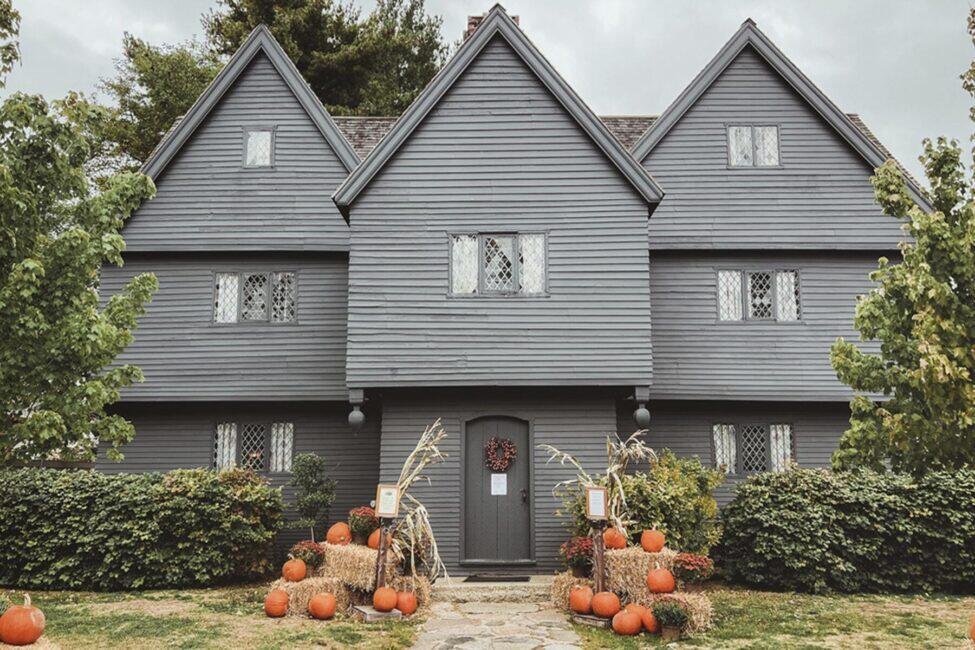The history of the Salem Witch Trials draws millions of people to Salem every year. However, some of the most significant sites related to the 1692 witch hysteria extend beyond the "Witch City’s” borders.
When one thinks of witch history in the United States, it’s mostly Salem, Massachusetts, that comes to mind. After all, the 1692 namesake witch trials famously took place there. Curiously, though, only one visitable Salem structure exists with a direct connection to this hysteria: the “Witch House,” where Judge Jonathan Corwin, who presided over the trials, once lived.
But history-loving travelers who expand their wanderings beyond Salem’s city limits will find many more historically significant places waiting for them in Essex County, Massachusetts, including the homes, ruins, and museums listed below, which start north and work their way south for spooky yet streamlined sightseeing.

Parson Capen House
Topsfield, Massachusetts
This National Historic Landmark was the home of Joseph Capen from 1683 to 1725. His congregation included accusers, like the prominent Gould family; and the accused, like Mary Easty and Sarah Wildes. Despite his apparent support, Capen couldn’t prevent Easty from hanging on September 22, 1692.
That summer, Capen joined a group of ministers in warning Governor William Phips against the use of spectral evidence and folk methods like “the touch test” at trial. Capen also signed clergyman Increase Mather’s writings that denounced the use of spectral evidence, which led to the banning of its admittance in court and ended the hangings.
Recommended Fodor’s Video
To visit the Parson Capen House, schedule a free private tour at least two weeks in advance.
Salem Village Parsonage
Danvers, Massachusetts
These ruins, hidden in a residential neighborhood of the former Salem Village, are ground zero for the 1692 witch trials. Atop them sat Reverend Samuel Parris’ parsonage, who lived there with his wife, their three children, a niece, and two enslaved people. In early 1692, his nine-year-old daughter Betty and 11-year-old niece Abigail Williams became the first girls to display afflictions like barking and staring off into space, which the perplexed local physician, Dr. Griggs, attributed to “an Evil Hand.” The accusations grew from there, beginning with Tituba, whom the Parris’s has enslaved.
Parris sent Betty to live at a relative’s house in Salem Town (today’s Salem), while Abigail remained in Salem Village and became a principal witch trials accuser. Tucked down a path between 67 and 69 Centre Street, the parsonage no longer stands, but the foundation ruins are always free and accessible to the public.
INSIDER TIPLeave your car in the parking lot behind the Witchcraft Victim’s Memorial on Hobart Street and make the one-quarter-mile walk to the parsonage ruins.

Rebecca Nurse Homestead
Danvers, Massachusetts
The Rebecca Nurse Homestead in the former Salem Village is the only home of a witch trials victim that is open to the public. The infirm 71-year-old Rebecca Nurse, a respected church member, was in bed during March of 1692 when she learned that Abigail Williams and others had accused her of witchcraft. At her examination at the Salem Village meetinghouse (a full-size replica exists on the property), she attested, “I am as innocent as the child unborn” before being sent to the dark, rank Salem jail. Her husband Francis and their eight grown children tirelessly advocated for her innocence, even submitting a petition with 39 signees to clear her name. Despite a brief reprieve when Salem Town’s grand jury trial pronounced her innocent, the immediate outburst by her accusers led the jury to reverse their decision. Rebecca was hanged at Salem’s Proctor’s Ledge on July 19, 1692.
Today you can enter this red-painted home and duck under the low-beamed ceilings that sheltered Rebecca as she received the grim news of her accusation. Per family lore, Rebecca may be buried on the grounds at the Nurse family cemetery, where a monument stands in her memory.
Balch House
Beverly, Massachusetts
Journey through Beverly’s oldest home, dating to 1679, to see the bedroom where 18-year-old David Balch fell fatally ill in 1690. The topic of his death resurfaced two years later when a neighbor who’d witnessed his decline testified to David’s claims of witches tormenting him at the foot of his bed. His alleged afflicters were Sarah Wildes, Dorcas Hoar, and an un-named person from Marblehead (likely Wilmott Redd), resulting in their imprisonment, and for Wildes and Redd, their execution.
Hale Farm
Beverly, Massachusetts
From 1694, this was the home of Reverend John Hale, who served in many capacities during the witch trials, witnessing examinations, receiving confessions, and even testifying against parishioners like Dorcas Hoar. Hale was fully convinced of witchcraft’s existence, especially after observing Betty Parris’ afflictions at the Salem Village parsonage. He would, however, grow increasingly skeptical as the proceedings progressed. Hale’s own wife was accused on spectral evidence in November of 1692, which likely solidified his doubts.
It was in this house’s study that Hale wrote his 1697 account of the trials, A Modest Enquiry Into the Nature of Witchcraft, which was published posthumously. During a guided tour, you can even see Hale’s writing desk where he may have drafted these writings, as well as period touches like gorgeous built-in cabinets and replica 19th-century wallpaper.
The Witch House
Salem, Massachusetts
Salem’s only publicly visitable structure with direct ties to the witch trials never housed any witches. However, this 1675 dwelling was once home to Judge Jonathan Corwin, who performed ruthless examinations alongside his counterpart John Hathorne at the Salem Village meetinghouse, local taverns, and, per unsubstantiated rumors, within his own home.
Both men led with a presumption of guilt and would not accept less than a full confession from the accused. The alternative usually meant a ticket to the gallows. After the trials, Corwin never showed remorse for his actions, going on to have a successful legal career and living to the age of 78.
A self-guided tour through this mansion gives insight into daily Puritan life, 17th-century architecture and furnishings, and most eerie of all, a display about corpse medicine.
INSIDER TIPVisiting Salem in October, especially close to Halloween, means long lines and navigating mobs of people donning witch hats on Essex Street. Either avoid driving to Salem by taking a 30-minute train from Boston or be sure to arrive no later than 9 a.m. to secure a parking spot and avoid traffic jams. An alternative is scheduling your trip for early November when the crowds dramatically drop off.
Peabody Essex Museum
Salem, Massachusetts
Salem’s Peabody Essex Museum is one of the oldest museums in the country and contains real artifacts relating to witch trial victims, accusers, judges, and ministers. The museum’s collection includes court documents, a hand-written petition, a sundial, and a walking stick.
Additionally, a special exhibition called “The Salem Witch Trials: Restoring Justice” is currently running through November 26, 2023, and focuses on the healing that has taken place in Salem and surrounding towns since 1692. This includes restitutions and exonerations, which even continue today (an accused witch was pardoned as recently as 2022).

Ambrose Gale House
Marblehead, Massachusetts
While you cannot enter this 1663 structure, a stroll through Old Town to the Ambrose Gale House transports you back to 17th-century Marblehead, when Ambrose Gale lived here with his widowed daughter Charity. Together, they were two of the three witnesses who testified against Wilmott Redd for cursing a Mrs. Syms with a “dry bellyache” five years earlier. Redd was ultimately convicted of witchcraft and became the only Marblehead woman to be either accused or executed during the 1692 witch trials.

Stroll to the foot of the Old Burial Hill (also a Hocus Pocus filming site) near Redd’s Pond to see the land upon which Redd and her husband Samuel once lived. Although her final resting place is unknown, you can find a memorial to Redd within the cemetery.



